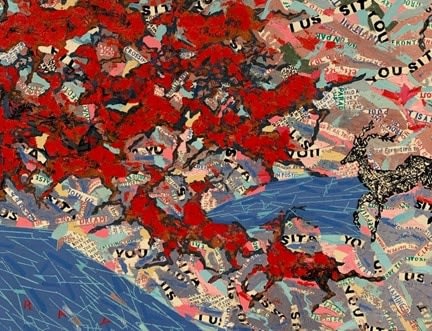
In a heavily-loaded art season there is one show that unquestionably outshines all others in its ambition, scale and range. This is the five month-long retrospective devoted to the Delhi-based, 81-year-old artist Arpita Singh that opened January-end at the Kiran Nadar Museum of Art (KNMA). About 220 works spanning six decades of her extraordinarily vivid and vibrant oeuvre are displayed in a series of interlinked rooms and galleries — some 18,000 sq ft of space — that counterpoise a woman’s inner journey with the vicissitudes of Indian life at large.
In explaining why Arpita Singh was chosen for this signal honour, Kiran Nadar, the influential institution-builder of the visual arts, says, “I hesitate to call Arpita Singh ‘a woman painter.’ She is quite simply one of the great modernists of our time. We strongly felt it was time to offer a major tribute that she so richly deserves.” Among the works displayed is a monumental 8ft x 12ft canvas titled “Sita in Torn-up Papers” specially commissioned by KNMA for this compelling show. Roobina Karode, the KNMA’s chief curator who undertook the mammoth exercise of research, planning and assembling such a large body of work (from collectors throughout the countryand from far-flung private and public collections in the United States and Japan) says her effort was to ensure that no period of the artist’s work went unrepresented. “Her works have oscillated from early figurative art and pure black-and-white abstracts of the 1960s and 1970s to a later narrative form. Yet her painterly language remains unique.”
Ghulam Mohammad Sheikh, the eminent Vadodara-based artist finds KNMA’s hosting of such retrospectives vital for another reason. “Our state-owned museums and galleries have abdicated responsibility and failed the public. It is therefore exciting that private patrons have now taken the initiative.”
Dinesh Vazirani, promoter of Saffronart, the country’s leading online auction house, salutes it as “a seminal show” ranking it on par, if not greater than big retrospectives in leading museums of the world.
Titled Submergence: In the Midst of Here and There, the bulk of Arpita Singh’s retrospective — large canvases in bold strokes of impasto, or delicate watercolours in an arresting palette of blues, pinks and yellows — can fleetingly evoke in the viewer a sense of the familiar, of playful reverie. But her quotidian imagery is darkened by satiric and subversive happenings that force us to look deeper, rummage through memory, and confront disturbing questions.
Menace lurks in the air. In a recurring leitmotif, why is the impassive mother-figure draped in widow’s whites, often under threat, sometimes by intruders with revolvers? When did the child-like images of birds mutate into threatening planes or vultures? The cars may seem toy-like — but hasn’t someone just been run over? Our ordered lives are disrupted by the art of Arpita Singh; by the eruption of violence, of black-coated functionaries and white-shrouded bodies. They will upturn our seemingly safe world.
In real life the artist, whom I have known since the early 1990s, is a shy, small-built woman, who dresses in plain saris of subtle weave and colour. Born Arpita Datta in Bara Nagar, Bengal, her father, a civil engineer, died early, and the family moved to Delhi at Partition. “One day, I saw an old Muslim man being killed by a mob. They beat him…then poured kerosene…and lit a match. I was nine years old. I have never forgotten the incident, but it has not haunted me nor showed up in my work,” she told the Paris-based art historian Deepak Ananth, in the major monograph on her work (Arpita Singh; Penguin Studio/Vadehra Art Gallery, 2015).
From her father she inherited a love for books and reading; but it was after art college, where she met and later married her Sikh husband Paramjit Singh, the painter of luminous landscapes, she worked at the Weaver’s Service Centre, and developed a keen interest in textiles.
In our many years of friendship I have never heard Arpita Singh talk about her art; it is a subject she studiously avoids. Behind her unruffled, retiring exterior is an iron disciplinarian. Each morning she ascends to her studio and works steadily for much of the day. “I neither plan a work nor take breaks nor pause. I just paint,” she gently said when I enquired after her daily regimen.
Few evenings are complete without a couple of hours devoted to reading — a wide-ranging, eclectic, often arcane choice of subject matter. Notebooks are always on hand for jottings. She is fascinated, for example, in ancient or indecipherable scripts. When I once asked what book she might like she mentioned the noted historian and archaeologist Nayanjot Lahiri’s Finding Forgotten Cities, an account of the excavation of Mohenjodaro and Harappa and the struggle to crack the Indus script.
Looking at the dense coda of numerals, lettering and unfinished sentences that pervade Arpita Singh’s art — hieroglyphics she has made her own — is like piecing together the enigmatic jigsaw of our incomplete lives. But it is just one of the many clues she offers.
-Sunil Sethi